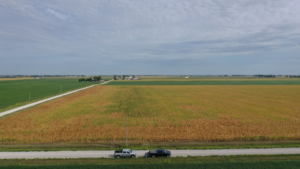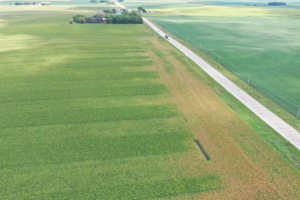Many producers have noticed an “edge effect” when assessing corn yields on the edge of the field as compared to yields on the interior of the field. Yields tend to be lower when the edge is oriented on the south or west side of the field and when adjacent to soybean, hay, or pasture. It is thought that the micro-climate at the field edge causes the edge yield penalty. Interestingly, when corn is grown in a narrow strip intercropped with soybean, the outside corn rows out yield the inner rows presumably because of increased light interception by the outer rows.(1) Research is currently being conducted at Iowa State University to determine the cause for the yield reduction associated with the field edge.(2)
The common explanation for this phenomenon is that hot and dry winds, blowing from the south or west across a lower statured crop (soybean, hay, pasture) to a corn field impact the outer corn rows by increasing the heat and/or drought stress. As temperature increases, the vapor pressure deficit increases as the surrounding air is much drier than the interior of the leaf. This in turn creates an increase in water demand by the corn plant, and in some cases it can double.
But that can occur throughout the field, so why does it impact just the field border?
The plants on the field border, particularly on the border that receives the prevailing hot and dry winds can have an increased vapor pressure deficit as the air at the leaf surface is continually replaced by drier air. In turn, this increases water demand by the plant and if this occurs in conjunction with a soil deficit, then the plant suffers stress resulting in a yield reduction.(3)

Figure 1. Note the stressed corn on the border with the road on the left and foreground.

